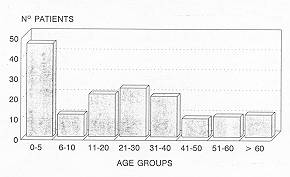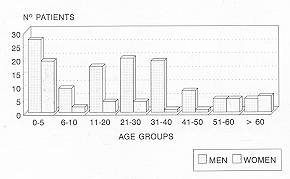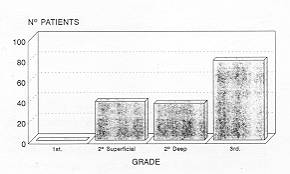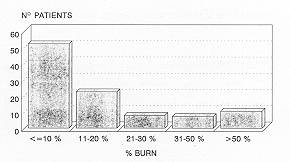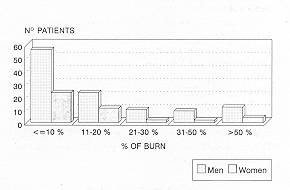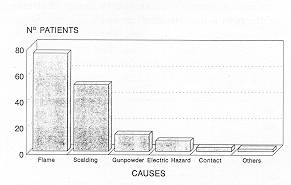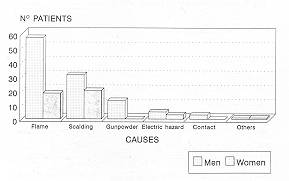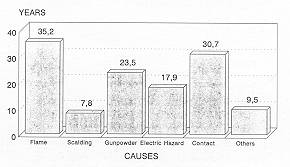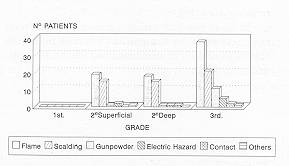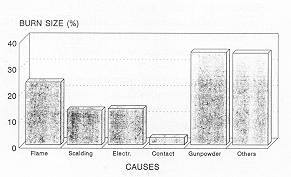| Ann. Medit. Burns Club - vol. VI - n. 4 - December 1993
EPIDEMIOLOGICAL ANALYSIS OF PATIENTS ADMITTED TO THE BURNS CENTRE IN VALENCIA DURING THE YEAR 1992 Serna Ballester C., Terren Ruiz J., Pous Serrano S., Dolz Lago J.F., Calvo Medina V., Mirabet Ippolito V. Departamento de Cirugia PIàstica y Grandes Quemados, Hospital Universitario La Fe, Valencia, Spain SUMMARY. We have performed a retrospective analysis of patients admitted to the Burns Centre of La Fe Hospital in Valencia (Spain) daring the year 1992 (152 cases, 110 men and 42 women). Regarding age, 38% of the patients were aged under 15 yr and 7.2% were over 60. The most frequent cause of burns was flame (49.3%), which caused both small and extensive wounds. The part of the body most frequently affected was the arm, so important in everyday work. Introduction It is important to identify the
epidemiological factors that cause burns. Materials and methods We have performed a retrospective
analysis of the 1 patients admitted to the Burns Centre in La Fe Hospital (Valencia),
between January and December, 1992, corresponding to a total of 152 patients. Results Age (Fig. 1)
The most frequently affected group was that of patients aged from 0 to 5 yr (30.3%), followed by patients aged 21 to 30 yr (15.8%). The least affected patients were those in the 41-50 yr age group (5.9%). 7.2% of the patients were aged above 60 yr. Sex (Fig. 2) Out of the 152 patients, 110 were men (72.4%) and 42 women (27.6%). More men were seen in all age groups except that aged 51 to 60 yr, in which the numbers of patients of both sexes were the same, and that over 60 yr, in which there were more women. extent, although we can see in Fig. 5 that men represent the majority in all groups.
Depth of burn (Fig. 3) None of the 152 patients presented superficial burns: 38 (25.0%) had partial-thickness burns, 36 (23.7%) and deep dermal burns and 78 (51.3%) fullthickness burns.
Body surface area burned (Fig. 4) Most of the patients (52.0%) presented burn of limited extent, i.e. up to 10% TBSA. However, only 27 patients (17.7%) had more than 30% TBSA burned (considered to be extensive burns). There is no statistical significance between sex and burn
Aetiology (Fig. 6) We have studied several factors as the cause of burns: flame, scalding, gunpowder, electricity, contact and other causes. The commonest cause was flame (49.3%), followed by scalding (33.6%). Gunpowder was the cause in 8.6% of cases. Regarding sex (Fig. 7), it was seen that only men are affected by burns caused by gunpowder and by contact. This relation has a statistical significance (p<0.05).
Fig. 8 shows how scalding affects younger
patients (mean age 7.8 yr). Flame affects adults (mean age 35.2 yr), as with contact burns
(mean age 30.7 yr). Gunpowder produced burns mainly in young people (mean age 23.5 yr),
and electricity in teenagers (mean age 17.9 yr).
Flame produced burns of all extents (Fig. 10), the same as scalding, although this did not produce burns from 31 to 50%. Electricity caused burns equal to or less than 10%, and 21 to 30%. Gunpowder was the origin of not only small but also extensive burns; contact with hot solids caused only limited burns. The relationship between aetiology and burn extent is statistically significant (p<0.05).
Localization (Fig. 11) The most frequent localization of burns considered in isolation was the head and neck (11 patients). However, most of the burns had several localizations. If we consider several isolated locations, the most affected were the arms (106 patients). Respiratory burns (21 patients) were always associated with burns in other body sites.
Table 1 shows the relationship between the origin of the burn and its localization. There is a significant relation (p<0.05) between burns in the arms (associated with other sites) and their cause, the most important being flame (52.8%), followed by scalding (2 1. 1 %), gunpowder (7.3 %) and electricity (4. 1 %).
There is also a significant relation
(p<0.05) with burns in the head and neck, flame being the most frequent cause (48%). Discussion Although a multifactorial protocol
was introduced in Spain to improve the epidemiological control of burns, at the beginning
of 1992, this still continues to be a problem.
The same applies to gunpowder burns, which affect the same population of young people using fireworks for fun. However, accidents producing serious burns always occur in factories where these products are manufactured. RESUME. Nous avons effectué une analyse rétrospective des patients hospitalisés dans le Centre des Brûlés à Valence (Espagne) pendant 1992 (152 cas, 110 hommes et 42 femmes). Pour ce qui concerne l'âge, 38 % des patients étaient âgés de moins de 15 ans et 7.2% de plus de 60. La cause des brûlures la plus fréquente était le feu, qui provoquait des lésions et petites et étendues. La partie du corps le plus fréquemment atteinte était le bras, tellement important dans le travail quotidien. BIBLIOGRAPHY
|
